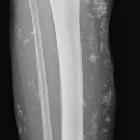jaccoud arthropathy
Jaccoud arthropathy is a deforming non-erosive arthropathy characterized by ulnar deviation of the second to fifth fingers with metacarpophalangeal joint subluxation.
Clinical presentation
Jaccoud arthropathy is characterized by marked ulnar subluxation and deviation at the metacarpophalangeal joints that is correctable or reducible with physical manipulation .
Pathology
It was traditionally described as occurring post-rheumatic fever. It is also seen in association with systemic lupus erythematosus (SLE) and other rheumatic and non-rheumatic conditions including psoriatic arthritis, inflammatory bowel disease and malignancy . It is thought to be related to ligamentous laxity .
Location
Typically affects the metacarpophalangeal joints but can also affect the proximal interphalangeal joints of the hands, wrists and knees .
Radiographic features
Plain radiograph
- hand radiographs typically show marked ulnar subluxation and deviation at the metacarpophalangeal joints
- absence of erosions is a notable feature, although occasionally "hook" erosions may be observed, which are similar to those seen in SLE and ankylosing spondylitis
- evidence of muscle (soft tissue) atrophy also may be present
History and etymology
It is named after F S Jaccoud, a French physician, who described the entity in 1869 .
Differential diagnosis
On imaging, possible considerations include:
- rheumatoid arthritis: presence of erosions is a key distinction
Siehe auch:
- Rheumatoide Arthritis
- systemischer Lupus Erythematodes
- Chronisch-entzündliche Darmerkrankungen
- Psoriasisarthritis
- Arthropathie
und weiter:

 Assoziationen und Differentialdiagnosen zu Jaccoud-Arthropathie:
Assoziationen und Differentialdiagnosen zu Jaccoud-Arthropathie:




